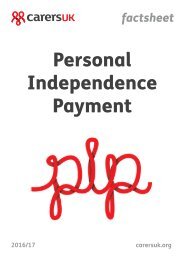data-protection-and-journalism-a-guide-for-the-media-draft
data-protection-and-journalism-a-guide-for-the-media-draft
data-protection-and-journalism-a-guide-for-the-media-draft
You also want an ePaper? Increase the reach of your titles
YUMPU automatically turns print PDFs into web optimized ePapers that Google loves.
Data <strong>protection</strong> <strong>and</strong> <strong>journalism</strong><br />
Data <strong>protection</strong> basics<br />
When does <strong>the</strong> DPA apply?<br />
The scope of <strong>the</strong> DPA is very wide. It applies to <strong>the</strong> processing of personal<br />
<strong>data</strong>. Broadly speaking, this means that anyone – including <strong>the</strong> <strong>media</strong> –<br />
must comply if <strong>the</strong>y h<strong>and</strong>le in<strong>for</strong>mation about people. This includes<br />
in<strong>for</strong>mation about employees, customers, contacts, sources, or people<br />
you are investigating or writing about.<br />
The DPA sets out a framework of rights <strong>and</strong> duties, which are designed to<br />
balance <strong>the</strong> legitimate needs of organisations to collect <strong>and</strong> use people’s<br />
details <strong>for</strong> business or o<strong>the</strong>r purposes (including <strong>journalism</strong>) against <strong>the</strong><br />
individual’s right to in<strong>for</strong>mation privacy. There are very few hard <strong>and</strong> fast<br />
rules. Instead, it is based around eight flexible common-sense principles.<br />
A number of exemptions disapply some of <strong>the</strong> provisions in some<br />
circumstances. There is an exemption <strong>for</strong> <strong>journalism</strong>, art <strong>and</strong> literature –<br />
but this does not mean <strong>the</strong> <strong>media</strong> are automatically exempt from <strong>the</strong> DPA<br />
as a whole. See chapter 4 below <strong>for</strong> more in<strong>for</strong>mation on when <strong>the</strong><br />
exemption applies <strong>and</strong> what it covers.<br />
It’s important to emphasise that <strong>the</strong> DPA will not prevent public interest<br />
<strong>journalism</strong>. But <strong>the</strong> <strong>media</strong> cannot ignore it altoge<strong>the</strong>r, <strong>and</strong> will need to be<br />
aware of <strong>the</strong> main principles <strong>and</strong> comply with <strong>the</strong>m wherever possible.<br />
What is ‘personal <strong>data</strong>’?<br />
The definition in <strong>the</strong> DPA is complicated. But in essence, personal <strong>data</strong> is:<br />
<br />
<br />
any in<strong>for</strong>mation about an identifiable living person<br />
which is (or will be) stored on a computer or o<strong>the</strong>r digital device, or<br />
filed in an organised filing system where it can be easily found.<br />
This means <strong>the</strong> DPA does not cover anonymous records, in<strong>for</strong>mation<br />
about <strong>the</strong> deceased, or unstructured paper records (eg h<strong>and</strong>written<br />
notebooks). However, in<strong>for</strong>mation in notebooks is covered if you intend to<br />
transfer it to a computer or filing system at a later date.<br />
Note that in<strong>for</strong>mation does not have to be ‘private’ to be personal <strong>data</strong>.<br />
Anything about a person can be personal <strong>data</strong>, even if it is innocuous or<br />
widely known. For example, a public figure’s job title can be personal<br />
<strong>data</strong>, as can a photograph taken in a public place, a listed phone number,<br />
DRAFT 13




